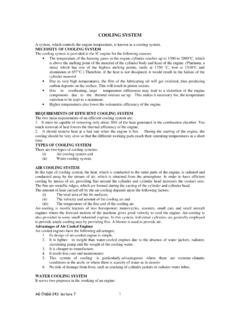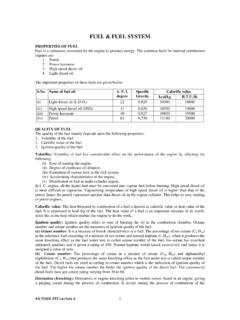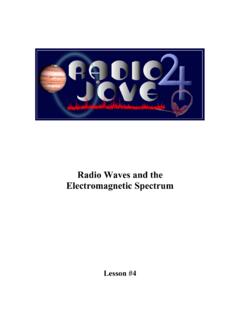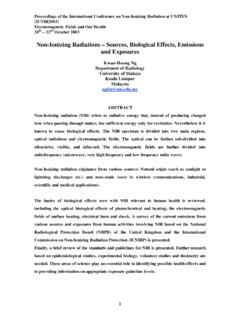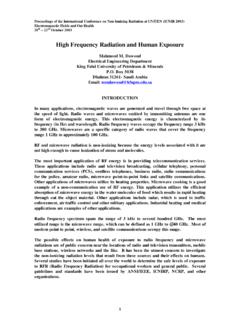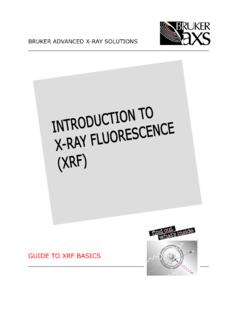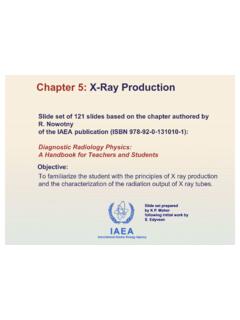Transcription of Chapter 5. Introduction to Remote Sensing
1 35 Chapter 5. Introduction to Remote Sensing What is Remote Sensing Remote Sensing is the science (and to some extent, art) of acquiring information about the Earth's surface without actually being in contact with it. This is done by Sensing and recording reflected or emitted energy and processing, analyzing, and applying that information. In much of Remote Sensing , the process involves an interaction between incident radiation and the targets of interest. This is exemplified by the use of imaging systems where the following seven elements are involved. Note, however that Remote Sensing also involves the Sensing of emitted energy and the use of non-imaging sensors.
2 1 Energy Source or Illumination (A) - the first requirement for Remote Sensing is to have an energy source which illuminates or provides electromagnetic energy to the target of interest. 2 Radiation and the Atmosphere (B) - as the energy travels from its source to the target, it will come in contact with and interact with the atmosphere it passes through. This interaction may take place a second time as the energy travels from the target to the sensor. 3 Interaction with the Target (C) - once the energy makes its way to the target through the atmosphere, it interacts with the target depending on the properties of both the target and the radiation. 4 Recording of Energy by the Sensor (D) - after the energy has been scattered by, or emitted from the target, we require a sensor ( Remote - not in contact with the target) to collect and record the electromagnetic radiation.
3 5 Transmission, Reception, and Processing (E) - the energy recorded by the sensor has to be transmitted, often in electronic form, to a receiving and processing station where the data are processed into an image (hardcopy and/or digital). 6 Interpretation and Analysis (F) - the processed image is interpreted, visually and/or digitally or electronically, to extract information about the target which was illuminated. 7 Application (G) - the final element of the Remote Sensing process is achieved when we apply the information we have been able to extract from the imagery about the target in order to better understand it, reveal some new information, or assist in solving a particular problem electromagnetic Radiation The first requirement for Remote Sensing is to have an energy source to illuminate the target (unless the sensed energy is being emitted by the target).
4 This energy is in the form of electromagnetic radiation. All electromagnetic 36 radiation has fundamental properties and behaves in predictable ways according to the basics of wave theory. electromagnetic radiation consists of an electrical field(E) which varies in magnitude in a direction perpendicular to the direction in which the radiation is traveling, and a magnetic field (M) oriented at right angles to the electrical field. Both these fields travel at the speed of light (c). The wavelength is the length of one wave cycle, which can be measured as the distance between successive wave crests. Wavelength is usually represented by the Greek letter lambda ( ). Wavelength is measured in metres (m) or some factor of metres such as nanometres (nm, 10-9 metres), micrometres ( m, 10-6 metres) or centimetres (cm, 10-2 metres).
5 Frequency refers to the number of cycles of a wave passing a fixed point per unit of time. Frequency is normally measured in hertz (Hz), equivalent to one cycle per second, and various multiples of hertz. The shorter the wavelength, the higher the frequency. The longer the wavelength, the lower the frequency. The electromagnetic spectrum The electromagnetic spectrum ranges from the shorter wavelengths (including gamma and x-rays) to the longer wavelengths (including microwaves and broadcast radio waves). There are several regions of the electromagnetic spectrum which are useful for Remote Sensing . For most purposes, the ultraviolet or UV portion of the spectrum has the shortest wavelengths which are practical for Remote Sensing .
6 This is a small visible portion relative to the rest of the spectrum . There is a lot of radiation around us which is "invisible" to our eyes, but can be detected by other Remote Sensing instruments and used to our advantage. The visible wavelengths cover a range from approximately to m. The longest visible wavelength is red and the shortest is violet. Some of common colors have the wavelength in following ranges: Violet: - mBlue: - mGreen: - mYellow: - mOrange: - mRed: - m Interactions with the AtmosphereBefore radiation used for Remote Sensing reaches the Earth's surface it has to travel through some distance of the Earth's atmosphere. Particles and gases in the atmosphere can affect the incoming and radiation.
7 These effects are caused by the mechanisms of scattering and absorptionA. SCATTERING occurs when particles or large gas molecules present in the atmosphere interact with and cause the electromagnetic radiation to be redirected from itscattering which take place. Rayleigh scattering occurs when particles are very small compared to the wavelength of the radiation. These could be particles such as small specks of dust or nitrogen and oxygen molecules. Rayleigh scattering causes shorter wavelengths of energy to be scattered much more than longer wavelengths. Rayleigh scattering is the dominant scattering mechanism in the upper atmosphere. The fact that the sky appears "blue" during the day is becaatmosphere, the shorter wavelengths ( blue) of the visible spectrum are scattered more than the other (longer) visible wavelengths.
8 At sunrise and sunset the light has to travel farther through theatmosphere than at midday and the scattering of the shorter wavelengths is more complete; this leaves a greater proportion of the longer wavelengths to penetrate the scattering occurs when the particles are just about the same size as theradiation. Dust, pollen, smoke and water vapour are common causes of Mie scattering which tends to affect longer wavelengths than those affected by Rayleigh scattering. Mie scattering occurs mostly in the lower portions of the atmosphereconditions are overcast. Non-selective scattering occurs when the particles are much larger than the wavelength of the radiation. Water droplets and large dust particles can cause m m m m m m Interactions with the Atmosphere Before radiation used for Remote Sensing reaches the Earth's surface it has to travel through some distance of the Earth's atmosphere.
9 Particles and gases in the atmosphere can affect the incoming and radiation. These effects are caused by the mechanisms of scattering and absorptionoccurs when particles or large gas molecules present in the atmosphere interact with and cause the electromagnetic radiation to be redirected from its original path. There are three types of occurs when particles are very small compared to the wavelength of the radiation. These could be particles such as small specks of dust cules. Rayleigh scattering causes shorter wavelengths of energy to be scattered much more than longer wavelengths. Rayleigh scattering is the dominant scattering mechanism in the upper atmosphere. The fact that the sky appears "blue" during the day is because of this phenomenon.
10 As sunlight passes through the atmosphere, the shorter wavelengths ( blue) of the visible spectrum are scattered more than the other (longer) visible wavelengths. At sunrise and sunset the light has to travel farther through theatmosphere than at midday and the scattering of the shorter wavelengths is more complete; this leaves a greater proportion of the longer wavelengths to penetrate the atmosphere. occurs when the particles are just about the same size as theradiation. Dust, pollen, smoke and water vapour are common causes of Mie scattering which tends to affect longer wavelengths than those affected by Rayleigh scattering. Mie scattering occurs mostly in the lower portions of the atmosphere where larger particles are more abundant, and dominates when cloud occurs when the particles are much larger than the wavelength of the radiation.
